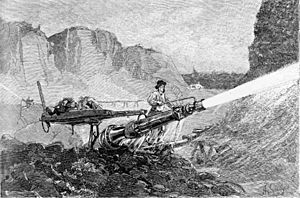Hydraulic mining facts for kids
Hydraulic mining is a type of mining that uses strong jets of water to break apart rock and dirt. This method helps miners move loose material or find valuable minerals hidden inside. When people mine for gold or tin this way, the water and dirt mixture flows through special long boxes called sluice boxes. These boxes help separate the heavier gold from the lighter dirt. Hydraulic mining is also used to dig for other materials like kaolin (a type of clay) and coal.
This mining method grew from old Roman techniques that used water to dig into soft ground. The modern way of hydraulic mining, which uses powerful water jets from a special tool called a "monitor," became popular in the 1850s during the California Gold Rush in the United States. Even though it was good at finding gold, using this method a lot caused big environmental damage. For example, it led to more floods, erosion (when soil washes away), and lots of sediment (dirt and sand) blocking rivers and covering farm fields. Because of these problems, rules and laws were made to control hydraulic mining. This method has been used in different forms all over the world.
Contents
How Hydraulic Mining Works
Using Water Power
Hydraulic mining uses a simple but powerful idea: water pressure. Imagine a very strong garden hose, but much, much bigger! Miners use a large nozzle called a "monitor" to shoot water at very high speeds. This powerful stream of water can break down hillsides, wash away dirt, and expose valuable minerals.
Finding Gold and Other Minerals
When miners are looking for gold, they often use this method in places where gold is found in loose deposits, like riverbeds or old streambanks. This is called placer mining. The strong water jets wash away tons of dirt and gravel. The water then carries this mixture, called a slurry, into long wooden or metal channels called sluice boxes.
Inside the sluice boxes, there are often ripples or traps. Gold is much heavier than dirt and sand. So, as the water flows through the sluice box, the heavier gold sinks and gets caught in these traps. The lighter dirt and gravel wash away. This helps miners collect the gold efficiently.
A Look at History
Ancient Beginnings
Using water to help with mining isn't a new idea. Ancient Romans, for example, used water to help them dig for minerals. They would build channels to bring water to a mining site. Then, they would release the water to wash away soft ground or help break up rock. This was a much simpler version of what we see today.
The California Gold Rush
The modern way of hydraulic mining really took off in the 1850s during the California Gold Rush. Thousands of people rushed to California hoping to find gold. At first, they used simple tools like pans and shovels. But as the easily found gold ran out, miners looked for faster ways to dig.
That's when they started using powerful water jets. This new method allowed a few miners to do the work of many. They could move huge amounts of earth quickly, finding gold that was buried deeper. It helped them find a lot of gold, but it also changed the landscape forever.
Environmental Impact
Changing the Landscape
While hydraulic mining was very effective for finding gold, it caused a lot of environmental problems. The powerful water jets washed away entire hillsides. This left behind huge, barren areas that looked like giant canyons, often called "diggins." The Malakoff Diggins State Historic Park in California is a good example of how much the land was changed.
Water Pollution and Flooding
All the dirt, sand, and gravel washed away by the water didn't just disappear. It flowed into rivers and streams. This made the water very muddy and choked up waterways. The extra sediment also made rivers shallower, which led to more flooding in nearby towns and farms. Farm fields were sometimes covered in thick layers of mud, making them unusable.
Legal Action and Regulation
Because of the widespread damage, people started to protest. Farmers and towns downstream were losing their land and homes to floods and sediment. Eventually, lawsuits were filed against the mining companies. In 1884, a famous court case in California, known as the "Sawyer Decision," largely stopped hydraulic mining in the state. This was one of the first big environmental protection rulings in the United States.
Today, hydraulic mining is still used in some places, but it is much more regulated. Rules are in place to try and reduce the harm it causes to the environment.
Images for kids
-
Gold miners excavate an eroded bluff with jets of water at a placer mine in Dutch Flat, California sometime between 1857 and 1870.
-
A man leans over a wooden sluice. Rocks line the outside of the wood boards that create the sluice.
-
The Malakoff Diggins, California, showing the effects of hydraulic mining on a hillside over a century later. Much of the effects of the mining was beyond the hills themselves, on the areas downstream of the water and sediment flow they produced.
See also
 In Spanish: Minería hidráulica para niños
In Spanish: Minería hidráulica para niños







